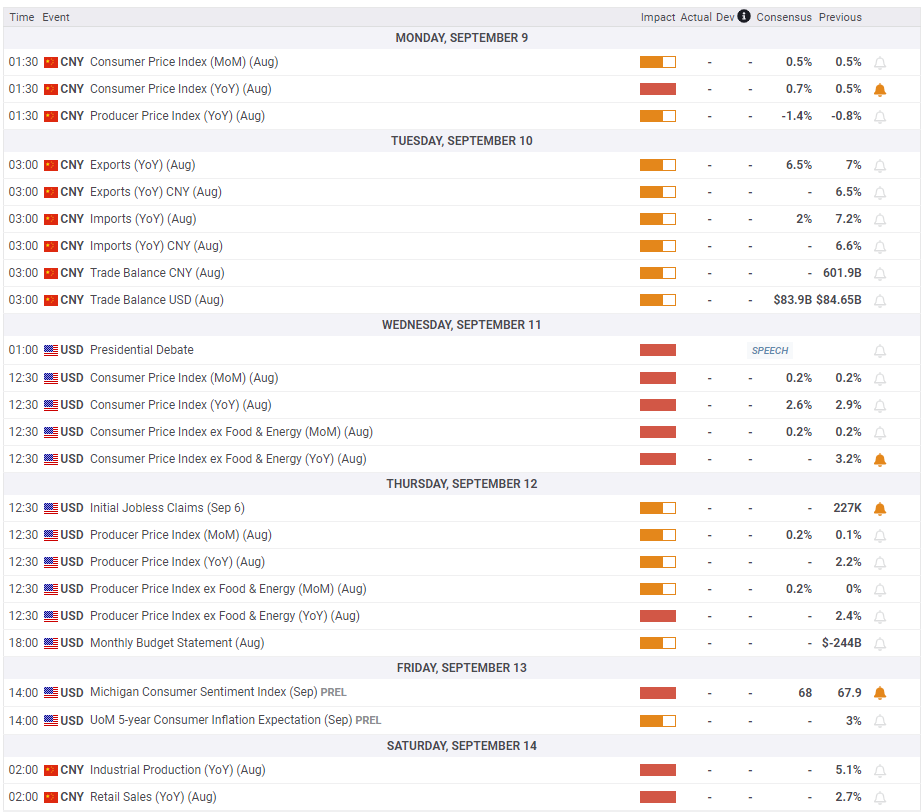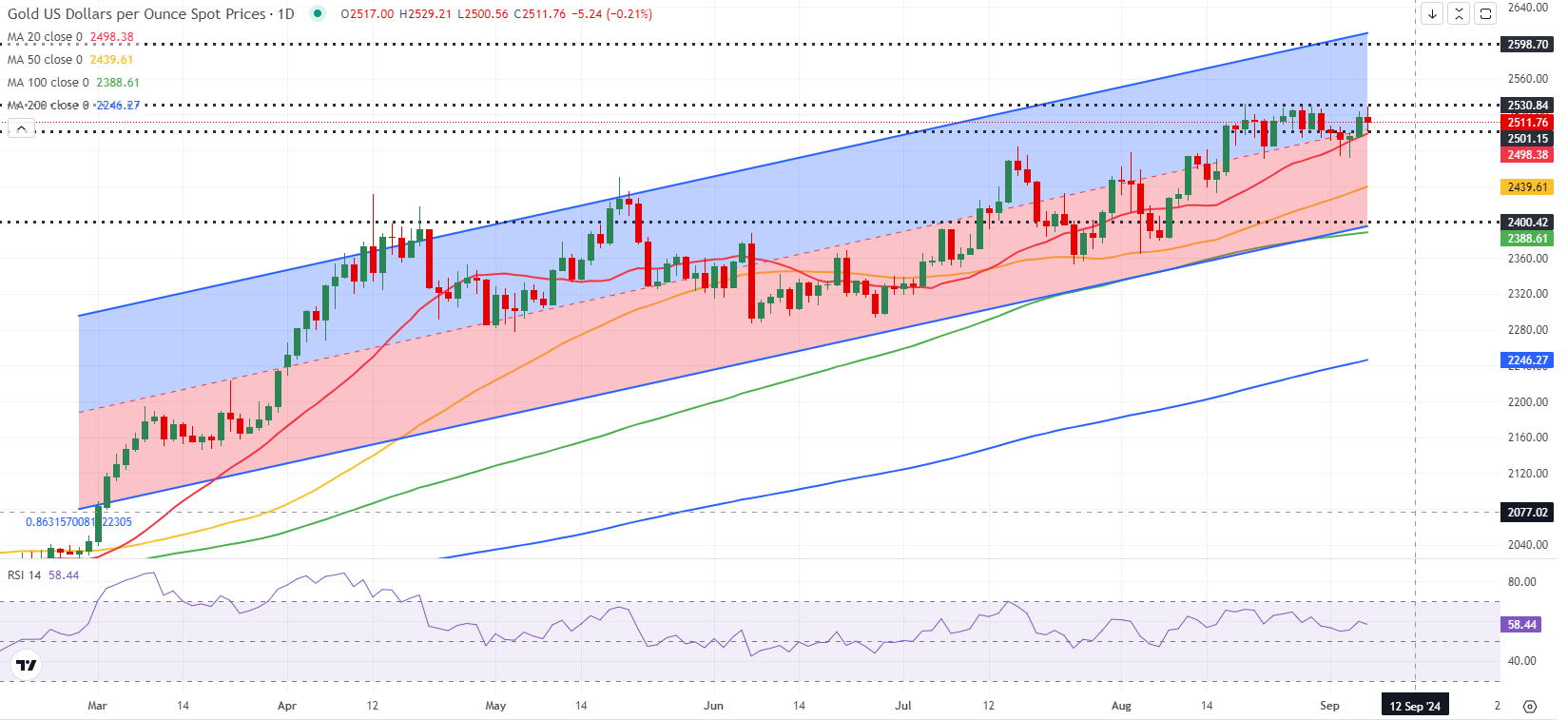- Gold regained its traction after dropping below $2,500 earlier in the week.
- The near-term technical outlook suggests that sellers remain on the sidelines.
- August Consumer Price Index (CPI) data from the US stand out in next week’s calendar.
After staying under modest bearish pressure in the first half of the week, Gold (XAU/USD) benefited from falling US Treasury bond yields and reclaimed $2,500. August inflation data from the US could fuel the next directional move in the precious metal.
Gold buyers continue to defend $2,500
Gold spent the first day of the week fluctuating in a tight range as trading conditions thinned out with the US financial markets remaining closed in observance of the Labor Day Holiday.
Wall Street’s main indexes declined sharply following the three-day weekend on Tuesday, allowing the US Dollar (USD) to gather strength and causing XAU/USD to drop below $2,500. On Wednesday, the USD came under selling pressure after the data published by the US Bureau of Labor Statistics (BLS) showed that the number of job openings on the last business day of July stood at 7.67 million, down from 7.9 million in June and below the market expectation of 8.1 million.
As Gold recovered back above the key $2,500 level early Thursday, technical sellers took action and helped the yellow metal extend its recovery. In the American session, the Automatic Data Processing (ADP) reported that employment in the private sector rose by 99,000 in August. This reading followed the 111,000 (revised from 122,000) increase recorded in July and missed the market expectation of 145,000 by a wide margin. The benchmark 10-year US Treasury bond yield dropped toward 3.7% and paved the way for another leg higher in XAU/USD.
On Friday, the BLS announced that Nonfarm Payrolls rose by 142,000 in August, falling short of the market forecast of 160,000. Additionally, July’s increase of 114,000 was revised down to 89,000. Other details of the jobs report showed that the Unemployment Rate edged lower to 4.2%, as expected. As the 10-year US extended its weekly decline and slumped below 3.7% after these readings, Gold held its ground heading into the weekend.
Gold investors await US inflation data
Trade Balance data from China could trigger a reaction in Gold during the Asian trading hours on Tuesday. In case China’s trade surplus widens noticeably in August, the immediate reaction could help Gold stretch higher because China is the world’s biggest consumer of Gold. On the flip side, investors could grow concerned about Gold’s demand outlook and cause the price to turn south in the near term if the trade surplus shrinks.
On Wednesday, August Consumer Price Index (CPI) data from the US will be watched closely by market participants. On a monthly basis, the CPI and the core CPI, which excludes volatile food and energy prices, are both forecast to rise 0.2%. In case the core CPI increases by 0.4% or more, US Treasury bond yields could rebound and cause Gold to lose its footing. On the flip side, a reading at or below the market forecast could make it difficult for the USD to attract investors and help XAU/USD push higher.
On Thursday, the European Central Bank (ECB) will announce monetary policy decisions. Although this event is unlikely to have a direct impact on Gold’s valuation, it could influence the USD’s valuation. A dovish ECB surprise could allow the USD to capture capital outflows out of the Euro and limit XAU/USD’s upside.
Assessing the current market positioning in Gold, “our read on positioning dynamics is now already at extreme levels that have historically marked significant turning points in Gold markets,” TD Securities Senior Commodity Strategist Daniel Ghali said in a report. “Macro fund positioning is now at levels only seen during the Brexit referendum in 2016, the ‘stealth QE’ narrative in 2019, or in the peak panic of the Covid-19 crisis in March 2020. This time around, physical markets have already fizzled out, whereas we also see extremes in Shanghai trader positions alongside CTA trend followers. Downside risks are more potent,” Ghali added.
Gold technical outlook
The bullish bias remains unchanged in the near term, with the Relative Strength Index (RSI) indicator on the daily chart holding near 60 and Gold trading within the upper half of the ascending regression channel coming from early March.
Immediate support is located at $2,500 (20-day Simple Moving Average (SMA), mid-point of the ascending regression channel). If Gold falls below this level and confirms it as resistance, $2,440 (50-day SMA) could be seen as the next support before $2,400 (lower limit of the ascending channel.
On the upside, the first resistance is located at $2,530 (static level). Once Gold clears this hurdle, it could target the upper limit of the ascending channel at $2,600.
Gold FAQs
Gold has played a key role in human’s history as it has been widely used as a store of value and medium of exchange. Currently, apart from its shine and usage for jewelry, the precious metal is widely seen as a safe-haven asset, meaning that it is considered a good investment during turbulent times. Gold is also widely seen as a hedge against inflation and against depreciating currencies as it doesn’t rely on any specific issuer or government.
Central banks are the biggest Gold holders. In their aim to support their currencies in turbulent times, central banks tend to diversify their reserves and buy Gold to improve the perceived strength of the economy and the currency. High Gold reserves can be a source of trust for a country’s solvency. Central banks added 1,136 tonnes of Gold worth around $70 billion to their reserves in 2022, according to data from the World Gold Council. This is the highest yearly purchase since records began. Central banks from emerging economies such as China, India and Turkey are quickly increasing their Gold reserves.
Gold has an inverse correlation with the US Dollar and US Treasuries, which are both major reserve and safe-haven assets. When the Dollar depreciates, Gold tends to rise, enabling investors and central banks to diversify their assets in turbulent times. Gold is also inversely correlated with risk assets. A rally in the stock market tends to weaken Gold price, while sell-offs in riskier markets tend to favor the precious metal.
The price can move due to a wide range of factors. Geopolitical instability or fears of a deep recession can quickly make Gold price escalate due to its safe-haven status. As a yield-less asset, Gold tends to rise with lower interest rates, while higher cost of money usually weighs down on the yellow metal. Still, most moves depend on how the US Dollar (USD) behaves as the asset is priced in dollars (XAU/USD). A strong Dollar tends to keep the price of Gold controlled, whereas a weaker Dollar is likely to push Gold prices up.
Information on these pages contains forward-looking statements that involve risks and uncertainties. Markets and instruments profiled on this page are for informational purposes only and should not in any way come across as a recommendation to buy or sell in these assets. You should do your own thorough research before making any investment decisions. FXStreet does not in any way guarantee that this information is free from mistakes, errors, or material misstatements. It also does not guarantee that this information is of a timely nature. Investing in Open Markets involves a great deal of risk, including the loss of all or a portion of your investment, as well as emotional distress. All risks, losses and costs associated with investing, including total loss of principal, are your responsibility. The views and opinions expressed in this article are those of the authors and do not necessarily reflect the official policy or position of FXStreet nor its advertisers. The author will not be held responsible for information that is found at the end of links posted on this page.
If not otherwise explicitly mentioned in the body of the article, at the time of writing, the author has no position in any stock mentioned in this article and no business relationship with any company mentioned. The author has not received compensation for writing this article, other than from FXStreet.
FXStreet and the author do not provide personalized recommendations. The author makes no representations as to the accuracy, completeness, or suitability of this information. FXStreet and the author will not be liable for any errors, omissions or any losses, injuries or damages arising from this information and its display or use. Errors and omissions excepted.
The author and FXStreet are not registered investment advisors and nothing in this article is intended to be investment advice.
Recommended Content
Editors’ Picks

EUR/USD extends slide toward 1.0300, touches new two-year low
EUR/USD stays under bearish pressure and trades at its lowest level since December 2022 below 1.0350 on Thursday. The US Dollar benefits from the risk-averse market atmosphere and the upbeat Jobless Claims data, causing the pair to stretch lower.

GBP/USD slumps to multi-month lows near 1.2400 on broad USD strength
Following an earlier recovery attempt, GBP/USD reversed its direction and declined to its weakest level in nearly eight months near 1.2400. The renewed US Dollar (USD) strength on worsening risk mood weighs on the pair as trading conditions normalize after the New Year break.

Gold benefits from risk aversion, climbs above $2,640
Gold gathers recovery momentum and trades at a two-week-high above $2,640 in the early American session on Thursday. The precious metal benefits from the sour market mood and the pullback seen in the US Treasury bond yields.

XRP rockets 11% as Bitcoin starts New Year with bullish bang
Crypto majors zoomed higher in the past 24 hours as the market entered a widely expected bullish year, with Bitcoin inching above $95,000 to shake off losses from last week. XRP surged 11% to lead growth among majors as of Thursday, led by $1.3 billion worth of trading volumes on Korea-focused exchange UpBit.

Three Fundamentals: Year-end flows, Jobless Claims and ISM Manufacturing PMI stand out Premium
Money managers may adjust their portfolios ahead of the year-end. Weekly US Jobless Claims serve as the first meaningful release in 2025. The ISM Manufacturing PMI provides an initial indication ahead of Nonfarm Payrolls.

Best Forex Brokers with Low Spreads
VERIFIED Low spreads are crucial for reducing trading costs. Explore top Forex brokers offering competitive spreads and high leverage. Compare options for EUR/USD, GBP/USD, USD/JPY, and Gold.

